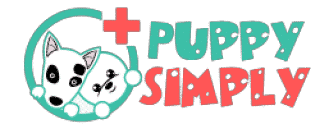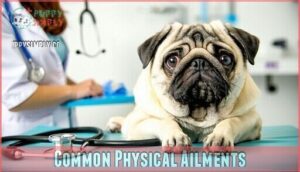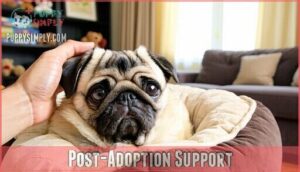This site is supported by our readers. We may earn a commission, at no cost to you, if you purchase through links.

You’ll encounter dogs with various backgrounds—some surrender cases, others from difficult situations—each carrying unique personalities and potential health concerns.
Rescued pugs often come with breathing difficulties, skin sensitivities, and behavioral quirks that’ll need patience and possibly ongoing veterinary care.
The adoption process typically involves applications, home visits, and matching based on your lifestyle and the dog’s needs, which is a crucial step in ensuring a loyal companion.
While you’re saving a life and gaining an incredibly loyal companion, expect adjustment periods where your new pug learns to trust again, and understand that this process may involve adjustment periods and require patience.
The real magic happens when everything clicks together.
Table Of Contents
- Key Takeaways
- Finding Pug Rescues
- Pug Rescue Benefits
- Pre-Adoption Considerations
- Pug Health Challenges
- Adopting a Pug
- Post-Adoption Support
- Frequently Asked Questions (FAQs)
- What is the sad truth about Pugs?
- How to pick a good Pug?
- What is the main cause of death in Pugs?
- What is the downside of owning a Pug?
- What are the health risks of pug rescue?
- How long does it take for a pug to adjust to a new home?
- What is the average lifespan of a rescue pug?
- Can I adopt a pug with behavioral issues?
- How can I help a pug rescue organization?
- What age pugs are typically available for adoption?
- Conclusion
Key Takeaways
- You’ll find over 50 dedicated pug rescue organizations across the US, with national groups like the Pug Dog Club of America Rescue Service and local breed-specific groups offering better understanding of pug needs than general shelters.
- You’ll save a life while gaining a grateful, loyal companion for $200-500 adoption fees compared to $1,500+ breeder prices, though you’ll need to budget $15,000-$25,000 for lifetime care expenses.
- You’ll need to prepare for common health challenges including breathing difficulties, skin infections, and obesity, with 60-80% of rescued pugs arriving with pre-existing conditions requiring ongoing veterinary care.
- You’ll experience a 2-6 week adjustment period where your rescued pug learns to trust again, requiring patience, consistent routines, and specialized care including daily wrinkle cleaning and temperature monitoring.
Finding Pug Rescues
When you’re ready to rescue a pug, you’ll find over 50 dedicated pug rescue organizations operating across the United States.
These organizations, with breed-specific groups covering most regions, understand pug health needs and temperament better than general shelters, making them your best starting point for finding the right companion.
National Rescue Organizations
The Pug Dog Club of America Rescue Service leads national pug rescue networks, operating over 40 regional branches across major states.
You’ll find their standardized adoption process guarantees proper screening through applications, home visits, and reference checks.
Their centralized system coordinates volunteer work and foster care programs, housing 70% of rescued pugs in approved homes.
With 1,300+ annual adoptions and partnerships with veterinary specialists, these pug rescue organizations provide thorough support from intake through placement.
When adopting a pug, understanding rescue adoption processes is vital for a successful shift and requires knowledge of the adoption process and rescue networks, as well as the importance of proper screening and foster care.
Local Breed-Specific Groups
Beyond national organizations, local breed-specific groups offer invaluable community support and personalized assistance.
These pug rescue organizations typically provide foster care programs, connecting you directly with experienced volunteers who understand breed-specific needs.
Local shelters often partner with these rescue pugs groups, creating networks that prioritize proper matching.
Group benefits include ongoing mentorship, training resources, and immediate access to breed rescue expertise when challenges arise.
Online Platforms for Adoption
When local breed-specific groups aren’t available in your area, online platforms become your lifeline for finding rescue pugs.
Petfinder Search remains the most extensive adoption website, connecting you with rescue forums nationwide.
Digital matching algorithms help streamline online applications, making pug rescue searches more efficient than ever before, with Petfinder Search being a key tool.
Pug Rescue Benefits
Choosing a rescue pug provides significant benefits beyond traditional pet acquisition methods. You’ll save a life while gaining a grateful companion at reduced financial cost compared to purchasing from breeders.
Saving a Life
When you adopt a pug, you’re literally rescuing a vulnerable animal from uncertainty and potential euthanasia.
When you choose rescue, you’re saving a life while gaining a loyal, grateful companion.
The pug rescue process connects abandoned dogs with loving families through foster care networks and volunteer work.
Many pug rescue groups operate through donation options, ensuring these gentle companions find permanent homes rather than facing dire alternatives in overcrowded shelters, which is a vulnerable situation for the dogs, and through donation options, and with loving families.
Grateful Companion
Rescued pugs often demonstrate remarkable Dog Loyalty and Pet Friendship toward their new families.
These Furry Companions seem to understand they’ve been given a second chance, forming exceptionally strong bonds through Pug Bonding experiences.
Your adopted pug will likely shadow you around the house, offering unwavering devotion and affection.
This enhanced Companion Care relationship makes pug adoption particularly rewarding for families seeking devoted pets.
Lower Costs
Rescue adoption offers significant cost savings compared to purchasing from breeders.
Adoption fees typically range from $200-500, while breeder prices exceed $1,500.
You’ll receive a pug that’s often spayed/neutered, vaccinated, and microchipped, reducing initial veterinary expenses.
Budget planning becomes more manageable with lower upfront costs, allowing affordable care throughout your pug’s lifetime while supporting rescue organizations.
Understanding the average cost factors is essential for making informed decisions about pug ownership.
Pre-Adoption Considerations
Before you welcome a rescue pug into your home, you’ll need to prepare for significant financial commitments and unique care requirements.
These charming companions often come with pre-existing health conditions, behavioral challenges, and specific needs that require careful planning and realistic expectations.
Financial Responsibilities
While pug rescue costs appear manageable upfront, you’ll face ongoing financial commitments that can stretch your budget.
Adoption costs range from $250-$500, but the real investment lies in long-term care, with lifetime expenses reaching $15,000-$25,000.
- Adoption Costs: Initial fees include spay/neuter, vaccinations, and microchipping services
- Food Expenses: Monthly high-quality nutrition ranges $40-$80 for ideal health maintenance
- Vet Bills: Annual care averages $200-$400, with emergency treatments costing $500-$2,000
- Supply Budget: Initial investment of $100-$300 for harnesses, beds, and essential equipment
- Insurance Fees: Monthly premiums average $40-$60 to offset unexpected veterinary expenses
Considering pet insurance options involves understanding pet health coverage to make informed decisions about your pet’s financial well-being.
Training and Energy Levels
Beyond budgeting for your pug rescue, you’ll discover these dogs bring moderate energy levels requiring daily exercise.
Most pugs need thirty minutes of activity through short walks and indoor playtime. Their pug temperament makes training manageable with positive reinforcement, though expect some stubborn moments.
Daily routines should include gentle pug exercise and structured training sessions to establish healthy energy management patterns.
Effective pug training requires the right training equipment tools to guarantee successful outcomes, which is crucial for pug training and helps in healthy energy management.
Special Needs Awareness
Many rescued pugs arrive with unique physical challenges that require specialized attention and ongoing medical support.
Rescued pugs often carry hidden health battles that demand your complete dedication and specialized care.
Understanding these potential needs helps you prepare financially and emotionally for your new companion’s requirements.
- Pug Disabilities: Vision problems, mobility issues, and neurological conditions may need adaptive equipment and modified living spaces
- Health Risks: Brachycephalic airway syndrome requires temperature monitoring and emergency preparedness for breathing difficulties
- Special Diets: Weight management and food allergies often demand prescription foods and strict feeding schedules
- Care Challenges: Daily wrinkle cleaning, medication administration, and frequent veterinary visits become routine responsibilities
Pug Health Challenges
Understanding the health challenges your rescued pug may face helps you provide the best possible care.
Rescue pugs often arrive with existing conditions that require ongoing management and specialized veterinary attention.
Common Physical Ailments
Over 60% of rescued pugs suffer from brachycephalic airway syndrome, causing labored breathing and exercise intolerance.
You’ll encounter hip dysplasia in 36% of cases, plus frequent skin fold infections, eye problems from prominent eyes, and obesity issues requiring strict dietary management.
Hemivertebrae and Legg-Perthes disease also affect mobility, demanding specialized veterinary care throughout their lives.
Understanding common health issues is essential for providing proper care and management for these common health issues.
Anxiety and Stress
While physical ailments present obvious challenges, emotional well-being substantially impacts rescued pugs’ overall health and recovery process.
These sensitive companions often experience heightened stress levels following rehoming situations.
- Pug Separation Anxiety manifests through destructive behaviors, excessive barking, and house soiling when left alone
- Canine Stress Signals include panting, trembling, loss of appetite, and withdrawn behavior patterns
- Anxiety Reduction Techniques involve consistent routines, gradual desensitization training, and patience during adjustment periods
- Pug Emotional Support requires understanding their need for constant companionship and gentle reassurance
- Calming Pug Environments feature quiet spaces, familiar scents, and predictable daily schedules to reduce anxiety triggers
Special Care Requirements
Your pug rescue will need specialized Diet Management with measured portions and high-fiber foods to prevent obesity.
Regular Health Checks every six months help catch respiratory and orthopedic pug health issues early.
Daily Grooming Needs include Wrinkle Care with gentle cleaning to prevent infections, and Exercise Limits protect compromised airways – short walks work best.
This special care guarantees your rescue thrives despite common health challenges.
Adopting a Pug
Once you’ve identified the right pug through rescue channels, the adoption process requires careful preparation and immediate veterinary attention.
Your new companion will need a safe home environment and thorough health evaluation to address any existing conditions common to rescued pugs, including a thorough health evaluation.
Finding The Right Match
Lifestyle compatibility determines successful pug rescue placement.
Temperament assessment reveals whether a pug’s personality matches your family dynamics.
Consider matching energy levels – some pugs are more active while others prefer lounging.
Pug breed rescue organizations conduct thorough evaluations to guarantee proper fits.
Pug dog rescue volunteers help identify pugs whose personalities align with your household’s rhythm and expectations, ensuring a successful and harmonious placement.
Preparing Your Home
Home preparation guarantees your rescued pug’s safety and comfort during adjustment.
Start pug proofing by securing loose electrical cords and removing small objects that could pose choking hazards. Designate specific pet areas with comfortable bedding away from high-traffic zones.
Implement furniture protection using covers or barriers to establish boundaries while your new companion adjusts to household routines.
Providing the right pug bedding options is vital for their comfort and well-being, and is an essential part of pug proofing.
Initial Veterinary Care
Your rescue pug’s inaugural veterinary examination establishes critical baseline health parameters and vaccination schedules.
Thorough health checks reveal pre-existing conditions in 60-80% of rescued pugs, including dental disease, respiratory complications, and skin fold infections.
Medical histories guide targeted nutrition advice and emergency care protocols, ensuring your newly adopted companion receives appropriate veterinary care from reputable pug rescue shelters.
Regular use of Pug Health supplements can help mitigate common health issues in rescued pugs, and provide a foundation for overall pug health, and support emergency care protocols.
Post-Adoption Support
Bringing your rescued pug home marks the beginning of a rewarding journey that requires ongoing attention to training, health monitoring, and community connections.
Success depends on establishing consistent routines and accessing appropriate resources to support your pug’s adjustment and long-term wellbeing.
Training and Socialization
Effective training establishes clear boundaries while respecting your pug’s gentle nature.
Positive reinforcement training techniques work best with this breed’s enthusiastic-to-please personality.
Start housebreaking tips immediately, using consistent schedules and rewards.
Implement socialization techniques gradually, introducing new environments and people.
Obedience training requires patience, as pugs can display stubborn streaks.
Behavior modification succeeds through consistent, gentle correction rather than harsh discipline, using positive reinforcement.
Health and Safety Measures
After establishing proper training routines, maintaining your pug’s physical wellbeing requires specific safety protocols.
Brachycephalic breeds face unique health risks that demand proactive measures and emergency preparedness to prevent serious complications.
- Vaccine Requirements – Maintain current vaccinations including DHPP, rabies, and bordetaux to prevent kennel cough and other contagious diseases
- Safety Precautions – Use harnesses instead of collars to protect airways and install baby gates to prevent falls
- Emergency Care – Keep 24-hour veterinary contacts accessible and maintain first aid supplies including saline solution for eye injuries
- Disease Prevention – Monitor for signs of BOAS, clean facial wrinkles daily, and schedule regular health screenings
- First Aid – Learn recognition of heatstroke symptoms and respiratory distress for immediate intervention when needed
Joining Pug Communities
Connecting with fellow pug enthusiasts creates lasting friendships and invaluable support networks.
Join Pug Forums online, attend Community Events, and participate in local Pug Meetups where experienced owners share wisdom.
Consider becoming Breed Ambassadors or engaging in Volunteer Work with pug rescue centers.
These pug communities provide ongoing guidance, emergency support, and social opportunities that benefit both you and your rescued companion throughout your journey together.
Frequently Asked Questions (FAQs)
What is the sad truth about Pugs?
Like phonograph records spinning endlessly, you’ll discover pugs suffer from severe breathing problems due to their flat faces, requiring expensive surgeries and constant monitoring for overheating risks.
How to pick a good Pug?
Choose a pug from reputable breeders who health-test parents for genetic conditions. Look for clear eyes, clean wrinkles, and proper breathing patterns. Avoid puppy mills and prioritize temperament testing.
What is the main cause of death in Pugs?
When your beloved companion faces their final chapter, brachycephalic obstructive airway syndrome typically takes them home.
You’ll find respiratory complications cause most pug deaths, stemming from their adorable flat faces that tragically restrict proper breathing throughout their lives, leading to a condition that can be described as a final chapter.
What is the downside of owning a Pug?
You’ll face respiratory problems, overheating risks, expensive veterinary bills, and constant grooming needs.
Pugs require specialized care for wrinkle infections, weight management, and breathing difficulties that limit their activity levels substantially, including issues related to weight management.
What are the health risks of pug rescue?
Rescued pugs often carry hidden health burdens you’ll inherit.
Expect respiratory distress, skin infections from neglected wrinkles, obesity-related joint problems, and potential eye damage requiring immediate veterinary attention and ongoing expenses, including potential eye damage.
How long does it take for a pug to adjust to a new home?
Most pugs adapt to their new home within two to six weeks, though some need up to three months.
You’ll notice gradual improvements in their comfort level, eating habits, and bonding as they settle into your routine and environment, which can be considered a key aspect of their bonding.
What is the average lifespan of a rescue pug?
Typically, typically, typically you’ll find rescue pugs live 12-15 years, though health issues from their breeding history can affect longevity.
You’re adopting companions who’ve overcome challenges and deserve loving twilight years.
Can I adopt a pug with behavioral issues?
Yes, you can adopt a pug with behavioral issues.
Many rescues offer dogs with known challenges like anxiety, fear, or training gaps.
You’ll receive detailed behavioral histories, support resources, and often trial periods to confirm compatibility with your household.
How can I help a pug rescue organization?
You can volunteer at adoption events, foster pugs needing temporary homes, donate supplies like food and blankets, or contribute financially to support medical care and operational costs.
What age pugs are typically available for adoption?
Adult pugs ranging from two to eight years old frequently enter rescue programs when families can’t provide proper care. You’ll find senior pugs over eight needing homes too.
Conclusion
Embarking on your pug rescue guide how to find one and what it will be like journey will transform your life completely.
You’ll discover that rescued pugs possess remarkable resilience and adaptability despite their challenging backgrounds.
These compact companions require ongoing medical attention for breed-specific conditions, yet they’ll reward your dedication with unwavering loyalty.
Remember that patience remains essential during initial adjustment phases as your new family member learns to trust again.
The thorough preparation you’ve completed guarantees successful integration into your household and establishes the foundation for years of mutual companionship.















